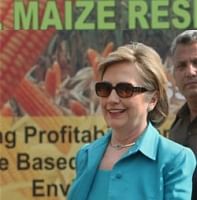

Within ten days of the G8 summit which pledged $20 billion to fight hunger, US secretary of state Hillary Clinton hinted at channelling a large chunk of that fund towards India to help in the global fight against hunger.
“India is farming for thousands of years. With three per cent of the world’s crop lands, it feeds 17 per cent of the world. Because of its unsurpassed experience, India can take a leadership position in the fight against hunger,” said Clinton.
At the L’Aquila G8 summit, world’s top industrialised nations have committed $ 20 billion to fight hunger. The US share in the kitty is $ 3.5 billion.
A substantial part of the money will be used to add value to agriculture products besides finding out high yielding varieties. India is expected to receive US financial help in post-harvesting technology and marketing value-based agro products besides wide scale promotion of low-input and high-yielding varieties.
On Sunday, when Clinton visited the Indian Agriculture Research Institute (IARI), she was shown three high-yielding semi-aromatic elongated rice varieties developed at the IARI including Pusa Basmati1 and Pusa Basmati 1121 and another type of rice. She was also appraised about dry seeding where farmers (with some initial capital investment) can sow without much water.
Cooperation in agriculture will be one of the cornerstones of the bilateral relationship between New Delhi and Washington as both will sign an agreement on agriculture cooperation on Monday.
The new agreement will pave the way for fresh funding on the farm sector. Not only there would be new money in agriculture cooperation, mainly from the hunger fund, but resource from a few of the existing programmes would also be diverted, she said. “There is no limit to what we are going to explore in agriculture,” Clinton said.
When Union Agriculture Minister Sharad Pawar said that India expected US assistance on front and bank-end linkage between agriculture and markets, she concurred by responding that India required more in food processing and value added agriculture.
While the aim of the bilateral programme will be to have more agro dollars in the hands of farmers, she said the US would monitor the programme closely to avoid unintended consequences that cropped up sometimes.
Clinton cites the example of a multilateral programme –– cereal systems initiative –– being run at the IARI where both governments, non-governmental organisation and a UN agency is involved to help six million farmers in south east Asia grow better crops with improved productivity.